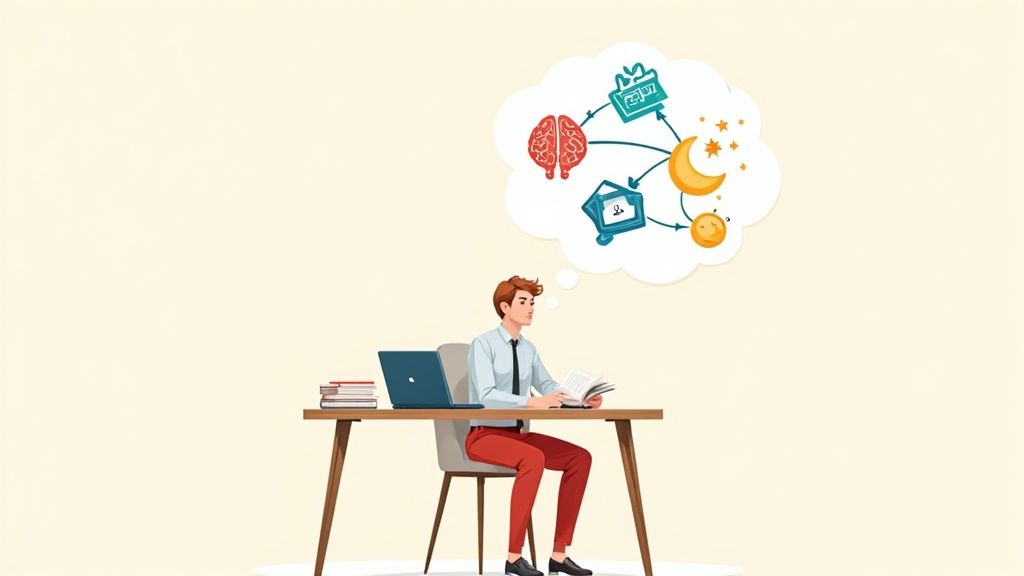So, you want to actually remember what you learn? Great! But first, you have to fight your brain's default setting: forgetting. The secret isn't just staring at your notes over and over. It’s about getting smart with strategies like active recall and reviewing stuff at just the right moments to lock it in for good.
Why We Forget Things So Quickly
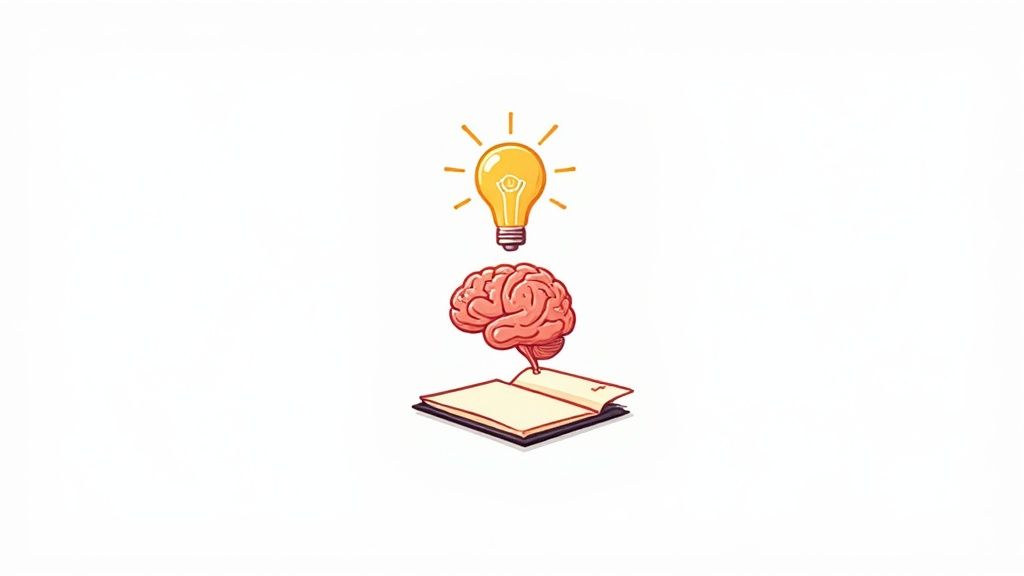
Ever walked out of a meeting and immediately blanked on a key detail someone just shared? Or maybe you’ve spent hours studying for an exam, only to feel like it all evaporated by morning. Look, it's not a sign of a "bad memory"—it's a feature, not a bug, of how our brains work.
Our brains are hit with a crazy amount of information every single second. To keep from short-circuiting, they have to be ruthless about what to keep and what to toss. Think of it as a built-in, automatic decluttering system that gets rid of anything it thinks is unimportant or isn't being used.
The Forgetting Curve Explained
This whole "in one ear, out the other" thing isn't just a feeling; it's a real, documented phenomenon. A 19th-century psychologist named Hermann Ebbinghaus was the first to map it out with what he called the Forgetting Curve. What he found was that our ability to recall new info plummets almost immediately after we learn it.
Without some kind of reinforcement, we lose a massive chunk of what we learn incredibly fast. The curve he plotted shows the sharpest drop in memory happens within the first day. This is exactly why cramming for a test feels so pointless a week later—the information never had a chance to stick.
The numbers are pretty staggering. Ebbinghaus's research showed that people forget roughly 70% of new material within just 24 hours and as much as 90% within a month if they don't bother to revisit it. You can dig into more modern data insights from the research highlighted on rivery.io.
Understanding this curve is the first real step to beating it. It perfectly shows why passive learning, like just rereading your notes, is so useless. Your brain flags it as low-effort and doesn't bother building the strong connections needed for long-term storage.
To truly hold onto information, you have to send a clear signal to your brain that "this is important, save it!" This is where active learning strategies come in, helping you not only learn but also process information faster and more effectively.
Upgrade Your Learning with Active Recall and Spaced Repetition
If you’re serious about making information stick, it's time to ditch passive learning. Simply rereading your notes, highlighting passages, or watching a video for the third time feels productive, but it’s often a waste of time. Most of that info leaks right back out.
The real shift happens when you go from a passive to an active approach.
Think of it this way: you don't learn to shoot a basketball by just watching games. You have to get on the court and take shots. The same deal applies to your brain. You have to actively pull information out of it, not just passively shovel it in.
Two of the most powerful, science-backed methods for doing this are Active Recall and Spaced Repetition.
Why Active Recall Is a Game-Changer
Active recall is exactly what it sounds like: actively yanking information from your memory without peeking at the source. It’s a mental workout. Every time you force your brain to dig up a fact, you strengthen the neural pathway to it, making that information easier to find the next time you need it.
The struggle is the point. When you have to work to remember something, you're sending a strong signal to your brain: "Hey, this is important! Keep it." Easy, passive review doesn't create that signal, so the information gets filed away as junk.
The data backs this up. One 2011 analysis found that active recall boosted learning outcomes by a whopping 43% compared to just rereading. In another real-world scenario, students who used quiz-based reviews scored 20-50% higher on exams than their friends who relied on passive study.
This is because retrieval isn't just about testing what you know; it's a huge part of the memory-making process itself.
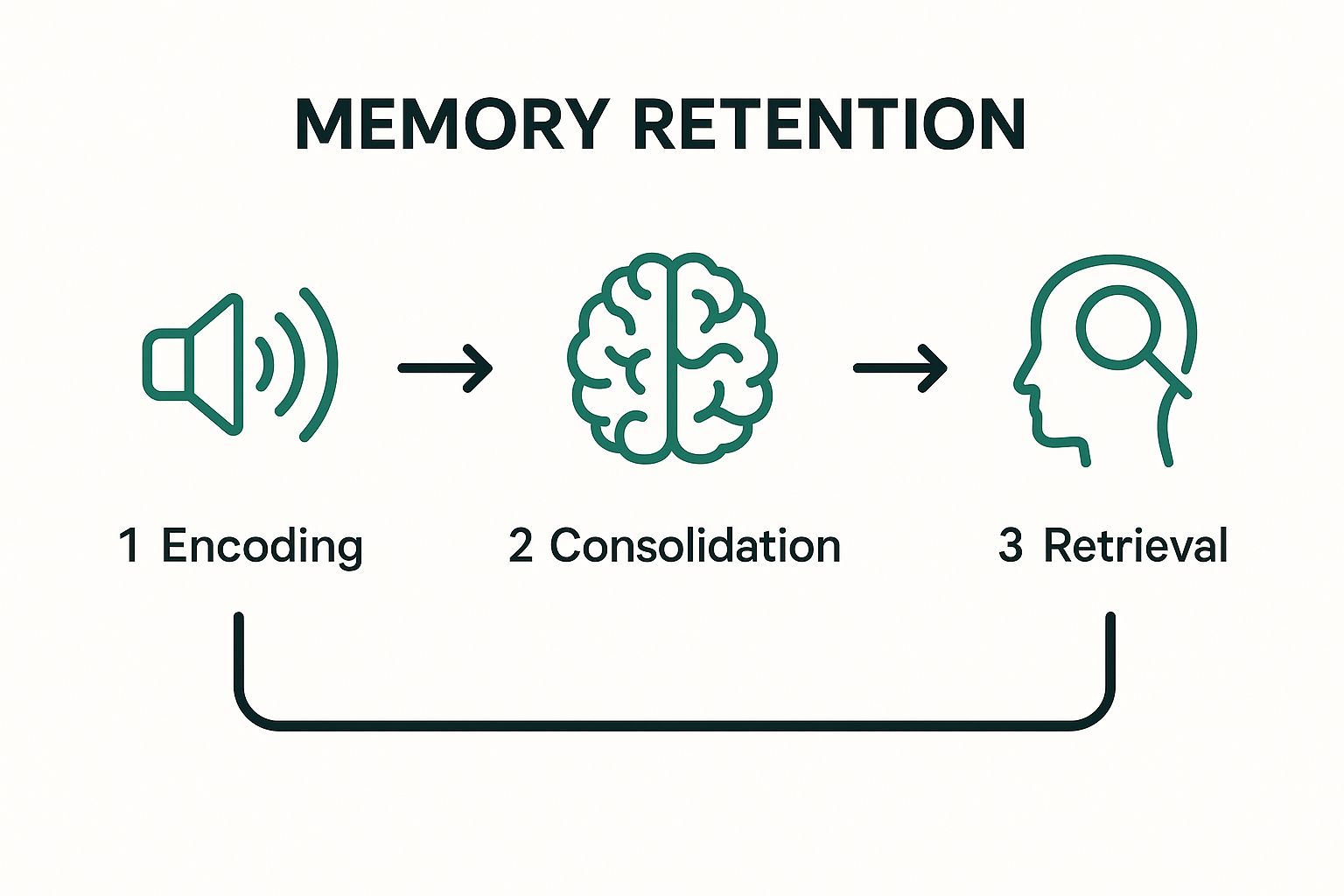
As you can see, pulling a memory out is what truly locks it in for the long haul.
Let's look at how this plays out in the real world with a quick comparison.
Passive vs Active Learning Showdown
Most of us default to passive methods because they feel easier. But "easy" rarely leads to strong retention. Here’s a look at how to flip common passive habits into high-impact active recall strategies.
| Passive Method (Low Retention) | Active Alternative (High Retention) | Why It Works Better |
|---|---|---|
| Rereading a chapter | Write a one-paragraph summary from memory after reading. | Forces you to actually process and pull out the key concepts. |
| Watching a tutorial video | Try to do the task yourself without the video playing. | Builds practical muscle memory instead of just recognizing it. |
| Highlighting key terms | Make flashcards and test yourself on the definitions. | Requires you to actively retrieve the meaning of each term. |
| Looking over old notes | Explain the main ideas from your notes to a friend (or a rubber duck!). | The act of teaching it solidifies your own understanding. |
Switching to these active methods might feel tougher at first, but that friction is exactly what makes the learning stick.
Lock It in With Spaced Repetition
Now, let's pair active recall with its perfect partner: spaced repetition. This is all about timing your reviews smartly. Instead of cramming, you revisit information at increasing intervals—right as you’re on the verge of forgetting it.
Think back to the "forgetting curve." Spaced repetition is your secret weapon to fight it. Reviewing too soon is a waste of time, and reviewing too late means you’ve already forgotten the material and have to start over. Spaced repetition hits that perfect sweet spot.
Here’s a simple, practical way to combine both methods:
- Scenario: You just sat through a training session on some new software for your job.
- Active Recall (Day 1): At the end of the day, jot down the three most critical features you learned without looking at your notes.
- Spaced Repetition (Day 2): The next morning, quiz yourself again. What were those features? How do they work?
- Spaced Repetition (Day 7): A week later, try explaining one of those features to a colleague. Can you walk them through it?
- Spaced Repetition (Day 30): A month from now, do a quick 60-second mental check-in on the core functions.
This system turns a huge, scary study task into a series of small, manageable check-ins. You can use digital flashcard apps like Anki, which have built-in algorithms to handle the spacing for you. But honestly, a few reminders in your calendar can work just as well. For even more options, check out our guide on the best apps for studying.
By blending the hard work of active recall with the smart timing of spaced repetition, you create a powerful one-two punch for moving knowledge from your leaky short-term memory into your permanent toolkit.
Sleep on It: Let Your Brain Lock In What You've Learned
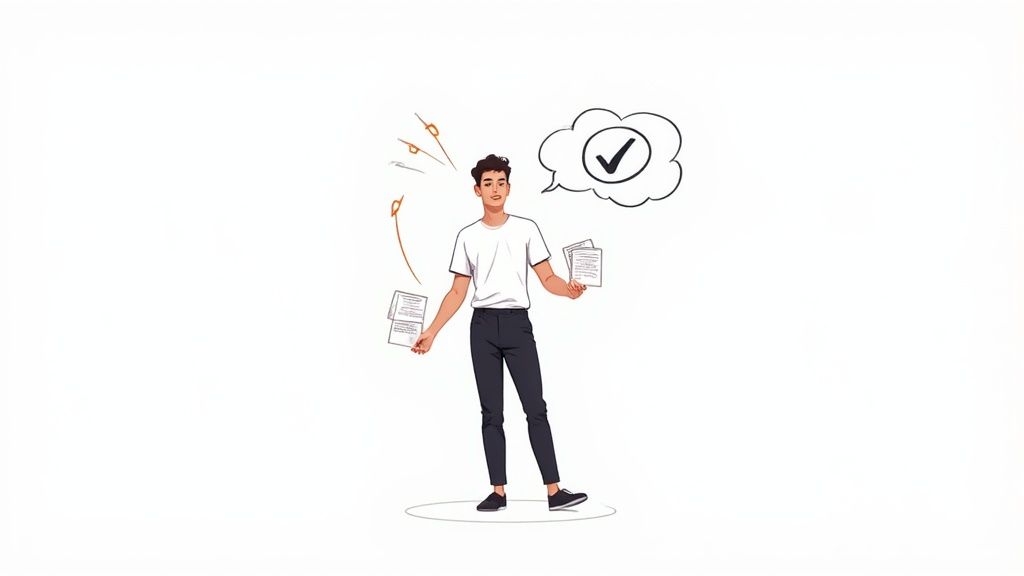
We've all been there: pulling an all-nighter before a big exam or a huge presentation. It feels like the most dedicated thing you can do, cramming every last bit of info into your head with the help of caffeine and pure willpower. But here’s the hard truth: it’s probably the worst thing for your memory.
Sleep isn't just about resting your body; it's a super important, non-negotiable part of the learning process.
Imagine your brain is a librarian who's just had a massive delivery of new books. During the day, they all get piled up near the front desk—a chaotic, disorganized mess. It's only overnight, when the library is closed, that the librarian can carefully sort through everything, decide what’s important, and shelve it in the right spot for long-term storage.
Without that nightly filing session, the information stays in a jumbled heap, making it nearly impossible to find when you actually need it.
How Your Brain Learns While You Sleep
So, what's really going on when you're out for the count? It's far from a simple shutdown. Your brain is incredibly active, cycling through different stages of sleep, with each one playing a specific role in cementing memories.
Take a look at this graphic from the Sleep Foundation, which shows the cycles your brain moves through all night long.

Both deep sleep (NREM) and dream sleep (REM) are essential. Deep sleep is the powerhouse for locking in facts and figures, while REM sleep helps with procedural memory—think mastering a new skill, like playing the guitar, or connecting ideas for creative problem-solving.
Sleep doesn't just store memories; it makes them stronger. Your brain replays the day’s key moments, reinforcing the connections tied to them. In a way, you're practicing in your sleep, making that new knowledge stick.
The science on this is crystal clear. Studies have shown that people who get a solid 6 to 8 hours of sleep after learning a new task can retain up to 20-30% more information than those who stay awake.
Even more shocking, just one night of skimping on sleep can slash your ability to recall what you learned by nearly 40%. You can read more about these findings in a study published by the American Psychological Association.
Practical Ways to Use Sleep for Better Learning
Knowing sleep is important is one thing; actually using it as a strategic learning tool is another. Here are a few things I’ve found that work wonders:
- Do a Quick Review Before Bed. Spend 10-15 minutes doing some active recall right before you turn out the lights. This simple act essentially flags the important information for your brain, telling it, "Hey, this is what you need to file away tonight."
- Stick to a Consistent Schedule. This is a game-changer. Going to bed and waking up around the same time every day—yep, even on weekends—regulates your body's internal clock. This leads to higher-quality sleep, making sure you get enough of both the deep and REM stages your brain needs.
- Ditch the "Catch-Up" Sleep Mentality. While sleeping in on Saturday feels awesome, it doesn't fully make up for the sleep debt you've built up all week. Consistency is always better for your memory than a boom-and-bust sleep cycle.
Making quality sleep a priority isn't about being lazy. It’s about being smart and working with your brain's natural rhythms to learn better and remember more.
Build a Mental Web with Visualization and Association
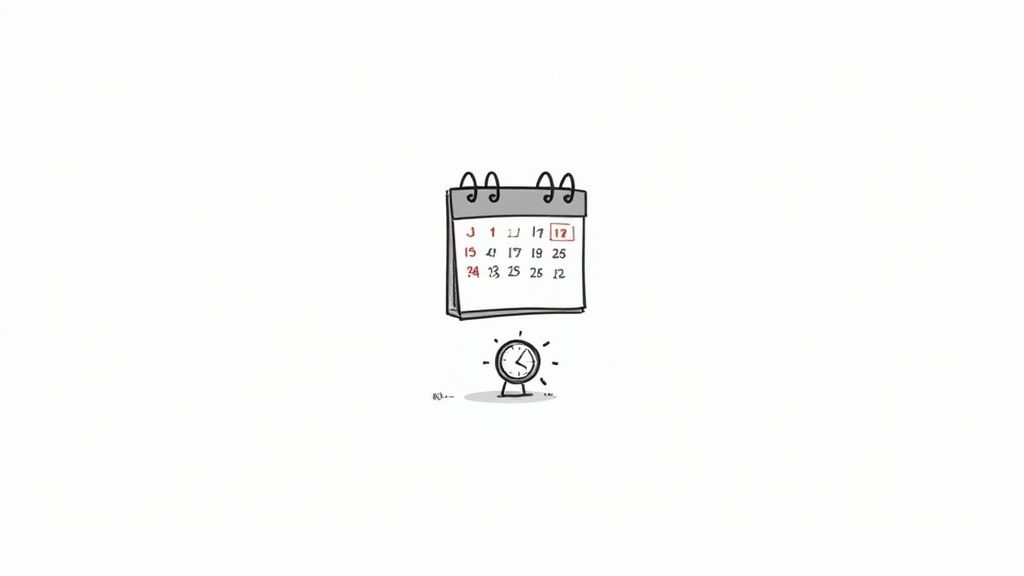
Ever notice how random facts seem to just disappear from your memory? It's like trying to grab smoke—they slip right through your fingers. That’s because isolated bits of information have nothing to hold onto in your brain.
The secret to making information stick is to connect it to stuff you already know. Don't just learn a new concept; weave it into your existing mental tapestry. This creates a strong web of knowledge where every idea reinforces the others.
For example, memorizing a string of historical dates is a classic struggle. Instead, try connecting them. What was happening in the art world when that battle was fought? Who were the major political figures, and what drove their decisions? When you start asking these questions, each new fact finds an anchor.
Turn Abstract Ideas into Vivid Pictures
One of the best tools for making these connections is visualization. Our brains are basically visual processors. In fact, research shows that when you vividly imagine something, your brain lights up a lot of the same regions as it would if you were actually doing it.
This is a huge advantage for learning. Abstract concepts, by their nature, are slippery and hard to grasp. But when you can translate a complex idea into a mental picture, you give your brain something solid to lock onto.
Let's take a concept like photosynthesis. Don't just read the definition. Close your eyes and really picture it. Imagine a leaf as a tiny, bustling, solar-powered factory. See the sunlight as energy packets being caught by little green workers (the chloroplasts). Picture water being drawn up from the roots through a complex plumbing system. It might sound a bit childish, but this mental movie is way more memorable than a dry, academic explanation.
Master the Art of Association
If visualization is about creating clear pictures, association is its creative, slightly weird cousin. It’s all about linking new information to something familiar—and the more bizarre and absurd the link, the better. Strange connections stand out, making them far easier to recall later. This is the exact principle behind the "memory palace" technique used by memory champions.
You don't need a fancy palace to make this work for you. Your own home is a perfect starting point. Say you need to remember a simple grocery list:
- Milk
- Eggs
- Bread
- Avocados
Instead of repeating the list over and over, walk through your house in your mind and create a ridiculous story. As you enter your living room, you see a cow happily splashing in your bathtub, which is overflowing with milk. You walk into the kitchen, and your favorite armchair is cracking open as tiny chicks hatch from eggs. The loaf of bread is on your bed, being used as a giant, fluffy pillow. And your TV? It’s displaying a single, giant, pulsating avocado.
This might seem like more effort up front, but it’s actually a shortcut. You're turning a dull, forgettable list into a vibrant, multi-sensory story. This plays directly to your brain's strengths—its incredible ability to remember stories and spatial layouts.
This technique is so effective because it taps into multiple senses and even emotions. You're combining visual, spatial, and narrative cues into one solid memory. If you want to explore more about engaging different senses in your learning, you might find our guide on what is multimodal learning interesting. By turning memorization into a creative act, you make the whole process more fun and, ultimately, far more successful.
Create Your Personal Retention Ritual
Knowing about active recall and spaced repetition is one thing. Actually *doing* it is where the real magic happens. A great strategy is useless if it just sits there, so our goal here is to build a simple, sustainable habit—what I call a "retention ritual."This isn't about cramming another massive task onto your already-packed to-do list. It’s about weaving small, powerful actions into your day until they feel as natural as brewing your morning coffee. The key is to make it personal, flexible, and almost effortless.
Find Your Rhythm
Your ritual has to fit your life, not the other way around. Are you a morning person who thinks best right after that first coffee? That’s probably the perfect time for a quick active recall session. Or maybe you're a night owl who unwinds by journaling? Tacking on a five-minute review before you go to sleep is an easy win.
The best retention ritual is the one you actually stick with. Forget about perfection. Aim for consistency, even if it’s just for five minutes a day. The compound effect of these small, regular efforts is insane over time.
Look for the natural gaps in your day. Could you use your bus ride to mentally quiz yourself on a new skill? Or maybe your lunch break is the ideal time to flip through a few flashcards. The trick is to anchor these new habits to ones you already have.
Building Your Weekly Retention Template
Let's get practical and sketch out what this might look like. Think of this as a starting point—grab what works for you and ditch what doesn't. Let's say you're trying to master a new software program at work.
Monday (Learn Day): You just finished a training session. Before logging off for the day, take 10 minutes to jot down the three most critical functions you learned, purely from memory. This is immediate active recall.
Tuesday (First Review): The next morning, try to recall those same three functions. If you get stuck, look them up. This should take you all of five minutes. You've just kicked off spaced repetition.
Thursday (Second Review): Find a coworker (or your dog, no judgment here) and try to explain one of the key software functions. Teaching something is one of the most powerful forms of active recall.
Sunday Evening (Weekly Recap): Set aside 15 minutes for a quick, low-stakes quiz on everything you've picked up that week. Then, right before bed, do a final two-minute mental run-through. This combines spaced repetition with a pre-sleep review.
This entire weekly "ritual" adds up to less than an hour, but it’s strategically timed to constantly interrupt the forgetting curve. By creating a predictable routine, you stop relying on fickle willpower and start running on habit. This is how you truly learn how to retain information better for the long haul.
Got Questions About Improving Your Memory?
Even with a solid game plan, you're probably wondering how these memory techniques actually play out in real life. Let's dig into some of the most common questions people have when they start trying to retain information more effectively.
How Quickly Can I Actually Expect to See Results?
You can notice a difference almost right away. Seriously. If you try using Active Recall immediately after a lecture—maybe by just scribbling down the key points from memory without looking at your notes—you'll be shocked at how much more you remember the next day. It’s a quick win that proves the concept.
Now, for building durable, long-term memory, think of it more like going to the gym. One workout isn't going to transform your body, but consistency is what builds real strength over time. In the same way, using Spaced Repetition builds powerful, lasting memory over weeks and months. Commit to a simple retention ritual for at least 3-4 weeks, and you'll feel a major, lasting shift in how well you hold onto new knowledge.
Can These Methods Help Me Remember Names and Faces?
Absolutely. We've all had that awkward moment of forgetting a name seconds after hearing it. These techniques are tailor-made for that exact problem.
- Association and Visualization: The moment you meet someone named "Mike," create a wild mental image of him holding a giant, shiny microphone. The more absurd, the better—our brains love novelty.
- Active Recall: Use his name a couple of times naturally during the conversation. A simple, "It was great to meet you, Mike," forces your brain to pull that name from short-term memory.
- Spaced Repetition: A few hours later, mentally quiz yourself: "Who did I meet at that event?" Try it again the next day. This simple, spaced-out practice is incredibly effective for cementing names.
The trick is to actively engage with the information in those first few critical moments. A simple mental picture or repeating the name aloud sends a clear signal to your brain: "Hey, this piece of data is worth keeping."
How Can I Apply This Stuff in My Professional Life?
These strategies are game-changers at work, even if your school days are long behind you. You don't need to break out a set of flashcards to make them work in a professional setting.
After a big project meeting, for example, fight the urge to immediately open your notes. Instead, take just two minutes at your desk to jot down the key decisions and action items entirely from memory. That's a perfect, low-effort application of Active Recall.
Or let's say you're learning a new company policy. Don't just read it once and hope for the best. Set a calendar reminder to quickly scan the main points one day later, then three days later, and again in a week. That’s Spaced Repetition integrated seamlessly into your workflow, helping you master new information without adding any extra stress.
Ready to turn your valuable content into an engaging, on-the-go learning experience? podcast-generator.ai can transform your articles, study guides, and reports into high-quality audio in minutes. Give your audience a new way to learn and retain information effortlessly. Create your first episode for free at podcast-generator.ai.
